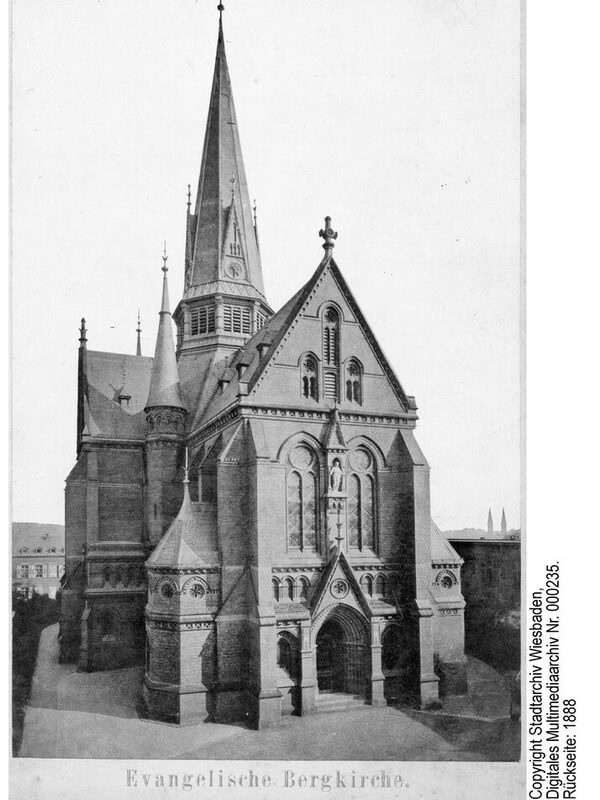Mountain church
The Protestant Bergkirche was built in 1876-79 as the second Protestant church after the Marktkirche. It is the focal point and landmark of the Bergkirche district named after it, which at the time was the quarter of the servants of the spa business. The architect was Johannes Otzen from Berlin, who later also drew up the plans for the Ringkirche. As with the Marktkirche, the building material was brick with cornices made of gray Palatinate sandstone. The architecture is based on the forms of the early Rhenish Gothic style. On 28.05.1879, the Bergkirche was consecrated by Bishop Dr. Ludwig Wilhelm Wilhelmi.
The Bergkirche was built on a cruciform ground plan. The crossing, which was extended to form an octagon and takes up the entire width of the nave, clearly approaches a central space. The high polygonal choir adjoins to the east, flanked by lower chapel-like sacristies. Of the cross arms to the north, south and west, the western one is designed as a short basilica nave. The octagon of the crossing is crowned by a tower, whose high pointed spire towers strikingly above the church building.
Architecturally, the Bergkirche is considered a precursor to the Ringkirche, as it does not yet meet the requirements of the Wiesbaden program. There are similarities between the two buildings in the stone galleries in the transept arms, the star vault in the crossing and, above all, in the spatial effect.
By Protestant standards, the Bergkirche is lavishly decorated with paintings, stained glass windows, statues and reliefs. The church has excellent acoustics and also has one of the most beautiful-sounding organs in Wiesbaden. The original organ from the company E. F. Walcker & Cie. in Ludwigsburg was rebuilt by the company G. F. Steinmeyer & Co. in the early 1930s. Albert Schweitzer, who had played the Bergkirchen organ, provided the inspiration for this. In 1938 and 1948, the sound was again redesigned.
During the Nazi era, the Bergkirche parish was a stronghold of resistance and the center of the Confessing Church in Wiesbaden under its pastors Franz von Bernus, Ludwig Anthes, Max Fries and Dr. Heinrich Vömel. They were supported by the Wiesbaden lawyer Dr. Hans Buttersack. The resistance fighter Hermann Kaiser also maintained contacts with the congregation, which had an extensive network of opponents of the Nazi regime. They even owned an illegal printing press. The Bergkirche has a special relationship with Martin Niemöller, who later became President of the Protestant Church in Hesse and Nassau.
In hardly any other Wiesbaden parish is the gap between rich and poor, between the residents of the Bergkirche district and the adjoining villas in the Nero Valley, between welfare recipients and millionaires, as wide as at the Bergkirche.
Literature
Bergkirche Wiesbaden. Schnell, Art Guide No. 2552, Regensburg 2004.
Gerber, Manfred; Sawert, Axel: Die Wiesbadener Bergkirche, Frankfurt am Main 2016.
Kiesow, Gottfried: Architectural Guide Wiesbaden. The City of Historicism, Bonn 2006 [pp. 133-135].
